 W
WAedes aegypti, the yellow fever mosquito, is a mosquito that can spread dengue fever, chikungunya, Zika fever, Mayaro and yellow fever viruses, and other disease agents. The mosquito can be recognized by white markings on its legs and a marking in the form of a lyre on the upper surface of its thorax. This mosquito originated in Africa, but is now found in tropical, subtropical and temperate regions throughout the world.
 W
WAedes albopictus, from the mosquito (Culicidae) family, also known as (Asian) tiger mosquito or forest mosquito, is a mosquito native to the tropical and subtropical areas of Southeast Asia; however, in the past few decades, this species has spread to many countries through the transport of goods and international travel. It is characterized by the white bands on its legs and body.
 W
WAedes japonicus, commonly known as the Asian bush mosquito or the Asian rock pool mosquito, was first described by Theobald in 1901 from Tokyo, Japan and has four known subspecies Ae. j. japonicus, Ae. j. shintienensis, Ae. j. yaeyamensis, and Ae. j. amamiensus. They are competent arbovirus vectors known to transmit the West Nile virus as well as Japanese and St. Louis encephalitis. They are listed as an invasive species by the Global Invasive Species Database.
 W
WAedes koreicus is a mosquito species originally described from Korea that has been shown to be enzootic to Japan, northeastern China, the Republic of Korea and parts of Russia, but recently found in Belgium, Italy and Germany. Adult Aedes koreicus are relatively large, with areas of white scales on black background, strongly resembling Aedes japonicus, which has also become established outside its native range.
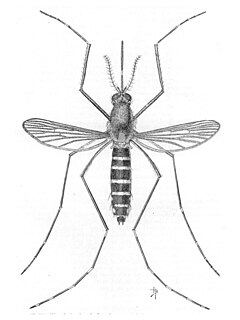 W
WAedes taeniorhynchus, or the black salt marsh mosquito, is a mosquito in the family Culicidae. It is a carrier for encephalitic viruses including Venezuelan equine encephalitis and can transmit Dirofilaria immitis. It resides in the Americas and is known to bite mammals, reptiles, and birds. Like other mosquitoes, Ae. taeniorhynchus adults survive on a combination diet of blood and sugar, with females generally requiring a blood meal before laying eggs.
 W
WAnopheles is a genus of mosquito first described and named by J. W. Meigen in 1818. About 460 species are recognised; while over 100 can transmit human malaria, only 30–40 commonly transmit parasites of the genus Plasmodium, which cause malaria in humans in endemic areas. Anopheles gambiae is one of the best known, because of its predominant role in the transmission of the most dangerous malaria parasite species – Plasmodium falciparum.
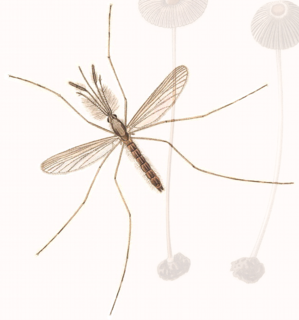 W
WAnopheles claviger is a mosquito species found in Palearctic realm covering Europe, North Africa, northern Arabian Peninsula, and northern Asia. It is responsible for transmitting malaria in some of these regions. The mosquito is made up of a species complex consisting of An. claviger sensu stricto and An. petragnani Del Vecchio. An. petragnani is found only in western Mediterranean region, and is reported to bite only animals, hence, it is not involved in human malaria.
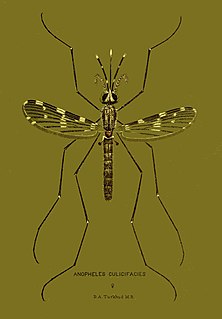 W
WAnopheles culicifacies is one of the major vectors of malaria on the Indian Subcontinent. It has been reported to be a species complex consisting of five sibling species which have been provisionally designated as species A, B, C, D, and E. It prefers to rest indoors in cattle sheds, where it feeds on cattle. The control of A. culicifacies has become a formidable task due to development of insecticide resistance against all commonly used insecticides, including new-generation insecticides such as synthetic pyrethroids.
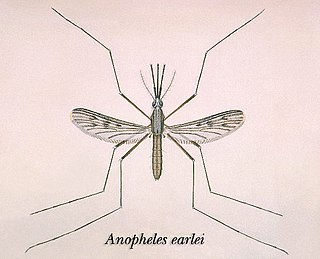 W
WAnopheles earlei is a small insect found throughout North America. The Anopheles earlei larvae are found in cold, clear water in ponds and other small bodies of water that contain plant life or vegetation.
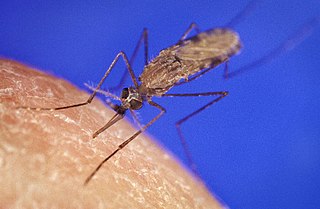 W
WThe Anopheles gambiae complex consists of at least seven morphologically indistinguishable species of mosquitoes in the genus Anopheles. The complex was recognised in the 1960s and includes the most important vectors of malaria in sub-Saharan Africa, particularly of the most dangerous malaria parasite, Plasmodium falciparum. It is one of the most efficient malaria vectors known. The An. gambiae mosquito additionally transmits Wuchereria bancrofti which causes Lymphatic philariasis, more commonly known as elephantiasis.
 W
WAnopheles punctipennis is a species of mosquito in genus Anopheles. It is native to North America.
 W
WA black fly or blackfly is any member of the family Simuliidae of the Culicomorpha infraorder. They are related to the Ceratopogonidae, Chironomidae, and Thaumaleidae. Over 2,200 species of black flies have been formally named, of which 15 are extinct. They are divided into two subfamilies: Parasimuliinae contains only one genus and four species; Simuliinae contains all the rest. Over 1,800 of the species belong to the genus Simulium.
 W
WThe Calliphoridae are a family of insects in the order Diptera, with 1,200 known species. The maggot larvae, often used as fishing bait, are known as gentles. The family is known to be polyphyletic, but much remains disputed regarding proper treatment of the constituent taxa, some of which are occasionally accorded family status.
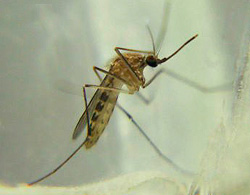 W
WCulex is a genus of mosquitoes, several species of which serve as vectors of one or more important diseases of birds, humans, and other animals. The diseases they vector include arbovirus infections such as West Nile virus, Japanese encephalitis, or St. Louis encephalitis, but also filariasis and avian malaria. They occur worldwide except for the extreme northern parts of the temperate zone, and are the most common form of mosquito encountered in some major U.S. cities, such as Los Angeles.
 W
WCulex annulirostris, commonly known as the common banded mosquito, is an insect native to Australia, Fiji, Micronesia, the Philippines and Indonesia. It is regarded as a serious pest species throughout its range.
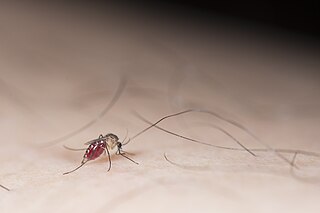 W
WCulex sitiens is an insect native to coastal areas of East Africa and Madagascar, southwestern Asia, Ryukyu Archipelago, Korea, northern Australia and South Pacific islands.
 W
WFlea, the common name for the order Siphonaptera, includes 2,500 species of small flightless insects that survive as external parasites of mammals and birds. Fleas live by consuming blood, or hematophagy, from their hosts. Adult fleas grow to about 3 millimetres long, are usually brown, and have bodies that are "flattened" sideways or narrow, enabling them to move through their host's fur or feathers. They lack wings, but have strong claws preventing them from being dislodged, mouthparts adapted for piercing skin and sucking blood, and hind legs extremely well adapted for jumping. They are able to leap a distance of some 50 times their body length, a feat second only to jumps made by another group of insects, the superfamily of froghoppers. Flea larvae are worm-like with no limbs; they have chewing mouthparts and feed on organic debris left on their host's skin.
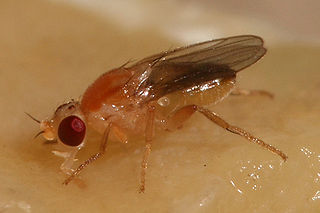 W
WHippelates is a genus of flies in the family Chloropidae and are often referred to as eye gnats or eye flies.
 W
WThe housefly is a fly of the suborder Cyclorrhapha. It is believed to have evolved in the Cenozoic Era, possibly in the Middle East, and has spread all over the world as a commensal of humans. It is the most common fly species found in houses. Adults are gray to black, with four dark, longitudinal lines on the thorax, slightly hairy bodies, and a single pair of membranous wings. They have red eyes, set farther apart in the slightly larger female.
 W
WLutzomyia is a genus of phlebotomine sand flies consisting of nearly 400 species, at least 33 of which have medical importance as vectors of human disease. Species of the genus Lutzomyia are found only in the New World, distributed in southern areas of the Nearctic and throughout the Neotropical realm. Lutzomyia is one of the two genera of the subfamily Phlebotominae to transmit the Leishmania parasite, with the other being Phlebotomus, found only in the Old World. Lutzomyia sand flies also serve as vectors for the bacterial Carrion's disease and a number of arboviruses.
 W
WA mosquito is any member of a group of about 3,500 species of small insects belonging to the order Diptera (flies). Within Diptera, mosquitoes constitute the family Culicidae. The word "mosquito" is Spanish and Portuguese for "little fly". Mosquitoes have a slender segmented body, one pair of wings, one pair of halteres, three pairs of long hair-like legs, and elongated mouthparts.
 W
WMosquito-malaria theory was a scientific theory developed in the latter half of the 19th century that solved the question of how malaria was transmitted. The theory basically proposed that malaria was transmitted by mosquitoes, in opposition to the centuries-old medical dogma that malaria was due to bad air, or miasma. The first scientific idea was postulated in 1851 by Charles E. Johnson, who argued that miasma had no direct relationship with malaria. Although Johnson's hypothesis was forgotten, the arrival and validation of the germ theory of diseases in the late 19th century began to shed new lights. When Charles Louis Alphonse Laveran discovered that malaria was caused by a protozoan parasite in 1880, the miasma theory began to subside.
 W
WMusca sorbens, the bazaar fly or eye-seeking fly, is a close relative of, and very similar in appearance to, the housefly. It is found in tropical and subtropical Africa, Asia and the Pacific Ocean region. It breeds in excreta, especially human faeces, and is the main insect vector of trachoma, a major cause of blindness.
 W
WThe Oriental rat flea, also known as the tropical rat flea, is a parasite of rodents, primarily of the genus Rattus, and is a primary vector for bubonic plague and murine typhus. This occurs when a flea that has fed on an infected rodent bites a human, although this flea can live on any warm blooded mammal.
 W
WPhlebotomus is a genus of "sand flies" in the Diptera family Psychodidae. In the past, they have sometimes been considered to belong in a separate family, Phlebotomidae, but this alternative classification has not gained wide acceptance.
 W
WRhodnius prolixus is the principal triatomine vector of the Chagas parasite due to both its sylvatic and domestic populations in northern South America as well as to its exclusively domestic populations in Central America. It has a wide range of ecotopes, mainly savanna and foothills with an altitude of between 500 meters to 1,500 meters above sea level and temperatures of 16 °C to 28 °C. Sylvatic R. prolixus, as virtually all Rhodnius spp., is primarily associated with palm tree habitats and has a wide range of hosts including birds, rodents, marsupials, sloths, and reptiles.
 W
WSimuliinae is a subfamily of black flies (Simuliidae). It contains over 2,200 species, with over 1,800 of them in the genus Simulium. There are 2 tribes and 25 living genera. A further 5 genera are known only from Cretaceous fossils.
 W
WThe Simuliini is a tribe of black flies that contains over 2,000 species, with more than 1,800 in the genus Simulium. There are 19 living genera, and three genera only known from Cretaceous fossils.
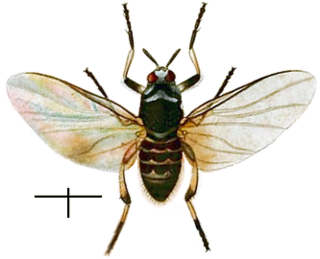 W
WSimulium is a genus of black flies, which may transmit diseases such as onchocerciasis. It is a large genus with several hundred species, and 41 subgenera.
 W
WSimulium yahense is a species of Black flies found in West African rain forests. Their larval stages are found in "smaller, more shaded, cooler breeding waters." One particular group, now eradicated, was found only on the island of Bioko, and was an extremely effective vector for the parasitic worm Onchocerca volvulus that causes onchocerciasis, or "River blindness".
 W
WTriatoma is a genus of assassin bug in the subfamily Triatominae. The members of Triatoma are blood-sucking insects that can transmit serious diseases, such as Chagas disease. Their saliva may also trigger allergic reactions in sensitive individuals, up to and including severe anaphylactic shock.
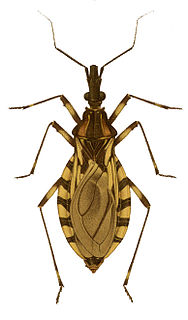 W
WTriatoma brasiliensis Neiva, 1911 is now considered the most important Chagas disease vector in the semiarid areas of northeastern Brazil. T. brasiliensis occurs in 12 Brazilian states, including Maranhão, Piauí, Ceará, Rio Grande do Norte, and Paraíba. T. brasiliensis is native to this part of Brazil, and thus persists in the natural environment. This species of Kissing Bug has the greatest potential to spread Chaga's disease due to its distribution over large areas where numerous people reside. Triatoma species are commonly called Kissing Bugs because they bite around the mouth where skin is thinner. T. brasiliensis also has the greatest potential to colonize new areas and spread throughout northeastern parts of Brazil. This makes control problematic.
 W
WTriatoma dimidiata is a blood-sucking insect whose range extends from northern South America, throughout all the countries of Central America and into Southern Mexico. It is among the most important carriers of Trypanosoma cruzi, the flagellate protozoa that causes Chagas disease. Dimidiata has been found in rock piles, caves occupied by bats, hollow trees occupied by mammals or birds, and other diverse ecotopes. However, their presence in human abodes is usually happenstance; people tend to bring them indoors with their firewood. When in the nymph form they may camouflage themselves from predators by scraping dust over their dorsal abdomen, a behavior also observed in T. phyllosoma, T. nigromaculata, Panstrongylus geniculatus, P. megistus and P. herreri nymphs. Moreover, due to geological past in Mesoamerica such as forest loss, and rising temperatures, there has been an increase in Triatomine bugs infestation.
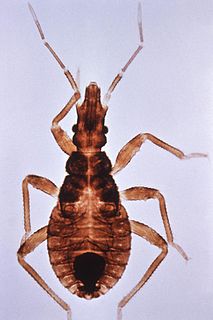 W
WTriatoma infestans, commonly called winchuka (vinchuca) in Argentina, Bolivia and Chile, barbeiro in Brazil, chipo in Venezuela and also known as "kissing bug" or "barber bug" in English, is a blood-sucking bug and the most important vector of Trypanosoma cruzi which can lead to Chagas disease. It is widespread in the Southern Cone countries of South America; in all these countries T. infestans is almost an exclusively domestic species, except in Bolivia where sylvatic forms have been recorded in rock piles in association with wild guinea pigs. This region has joined the control intervention called Southern Cone Initiative managed by the PAHO.
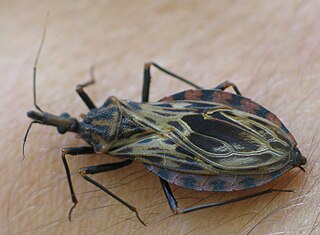 W
WTriatoma nigromaculata is a sylvatic species of insect usually found in hollow trees, in vertebrate nests on trees and occasionally in human dwellings. It usually lives in relatively humid forests at high altitudes on mountain regions and foot hills. As all members of the subfamily Triatominae, T. nigromaculata is a blood-sucking bug and a potential vector of Chagas disease. This species is distributed mainly in Venezuela, but some specimens have also been found in Perú and Colombia (Cauca).
 W
WTriatoma sanguisuga, also known as the Eastern Bloodsucking Conenose or the Mexican Bed Bug, is an insect of the Triatominae subfamily, known as kissing bugs. It is found throughout North America and Latin America, and is common in the Southeastern United States. They are generally 16 to 21 mm long, black or dark brown, with six reddish-orange spots along each side of a wide abdomen. They are winged, have kinked, six-segmented antennae, and have a slender, tapered proboscis used for feeding.
 W
WThe members of the Triatominae, a subfamily of the Reduviidae, are also known as conenose bugs, kissing bugs, or vampire bugs. Other local names for them used in Latin America include barbeiros, vinchucas, pitos, chipos and chinches. Most of the 130 or more species of this subfamily feed on vertebrate blood; a very few species feed on other invertebrates. They are mainly found and widespread in the Americas, with a few species present in Asia, Africa, and Australia. These bugs usually share shelter with nesting vertebrates, from which they suck blood. In areas where Chagas disease occurs, all triatomine species are potential vectors of the Chagas disease parasite Trypanosoma cruzi, but only those species that are well adapted to living with humans are considered important vectors. Proteins released from their bites have been known to induce anaphylaxis in sensitive and sensitized individuals.
 W
WTsetse, sometimes spelled tzetze and also known as tik-tik flies, are large biting flies that inhabit much of tropical Africa. Tsetse flies include all the species in the genus Glossina, which are placed in their own family, Glossinidae. The tsetse are obligate parasites that live by feeding on the blood of vertebrate animals. Tsetse have been extensively studied because of their role in transmitting disease. They have a prominent economic impact in sub-Saharan Africa as the biological vectors of trypanosomes, which cause human sleeping sickness and animal trypanosomiasis. Tsetse are multivoltine and long-lived, typically producing about four broods per year, and up to 31 broods over their lifespans.